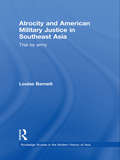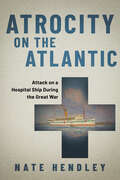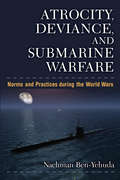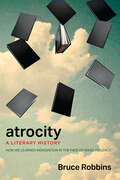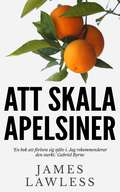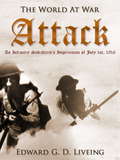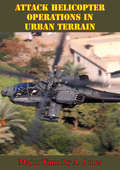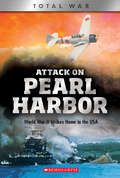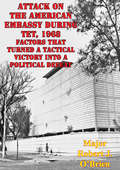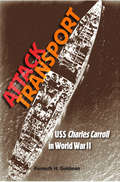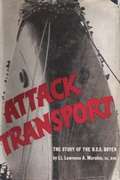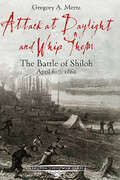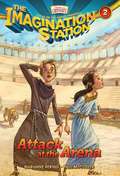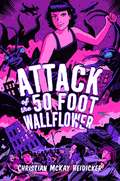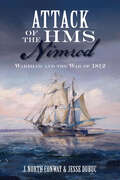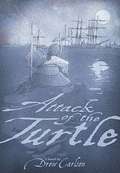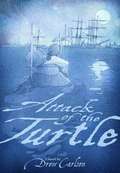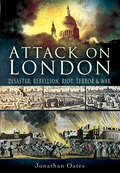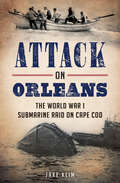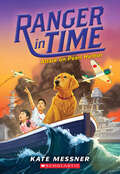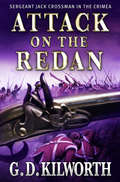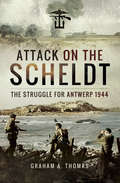- Table View
- List View
Atrocity and American Military Justice in Southeast Asia: Trial by Army (Routledge Studies in the Modern History of Asia)
by Louise BarnettThis book is an examination of American army legal proceedings that resulted from a series of moments when soldiers in a war zone crossed a line between performing their legitimate functions and committing crimes against civilians, or atrocities. Using individual judicial proceedings held within war-time Southeast Asia, Louise Barnett analyses how the American military legal system handled crimes against civilians and determines what these cases reveal about the way that war produces atrocity against civilians. Presenting these atrocities and subsequent trials in a way that considers both the personal and the institutional the author considers how and why atrocity happens, the terrain of justification, and the degree to which the army and American society have been willing to take military crimes against civilians seriously. Atrocity and American Military Justice in Southeast Asia will be of interest to students, scholars and professionals interested in Military Justice, Military history and Southeast Asian History more generally.
Atrocity on the Atlantic: Attack on a Hospital Ship During the Great War
by Nate HendleyHow a German submarine sank a Canadian military hospital ship during the First World War and sparked outrage.On the evening of June 27, 1918, the Llandovery Castle — an unarmed, clearly marked hospital ship used by the Canadian military — was torpedoed off the Irish Coast by U-Boat 86, a German submarine.Sinking hospital ships violated international law. To conceal his actions, the U-86 commander had the submarine deck guns fire on survivors. One lifeboat escaped with witnesses to the atrocity. Global outrage over the attack ensued.The sinking of the Llandovery Castle was adjudicated at the Leipzig War Crimes Trials, an attempt to establish justice after hostilities ceased. The Llandovery Castle case resulted in a historic legal precedent that guided subsequent war crime prosecutions, including the Nuremberg Trials.Atrocity on the Atlantic explores the Llandovery Castle sinking, the people impacted by the attack, and the reasons why this wartime atrocity was largely forgotten.
Atrocity, Deviance, and Submarine Warfare: Norms and Practices during the World Wars
by Nachman Ben-YehudaIn the early 20th century, the diesel-electric submarine made possible a new type of unrestricted naval warfare. Such brutal practices as targeting passenger, cargo, and hospital ships not only violated previous international agreements; they were targeted explicitly at civilians. A deviant form of warfare quickly became the norm. In Atrocity, Deviance, and Submarine Warfare, Nachman Ben-Yehuda recounts the evolution of submarine warfare, explains the nature of its deviance, documents its atrocities, and places these developments in the context of changing national identities and definitions of the ethical, at both social and individual levels. Introducing the concept of cultural cores, he traces the changes in cultural myths, collective memory, and the understanding of unconventionality and deviance prior to the outbreak of World War I. Significant changes in cultural cores, Ben-Yehuda concludes, permitted the rise of wartime atrocities at sea.
Atrocity: A Literary History
by Bruce RobbinsExploring literary representations of mass violence, Bruce Robbins traces the emergence of a cosmopolitan recognition of atrocity. Mass violence did not always have a name. Like conquest, what we think of now as atrocities have not always invited indignation or been seen to violate moral norms. Venturing from the Bible to Zadie Smith, Robbins explores the literature of suffering, to show how, over time, abhorrence of mass violence takes shape. With it comes the emergence of a necessary element of cosmopolitanism: the ability to look at one's own nation with the critical eyes of a stranger. Drawing on a vast written archive and with penetrating insight, Robbins takes up such literary representations of violence as Bartolomé de las Casas's account of his fellow Spaniards' atrocities, Kurt Vonnegut's Slaughterhouse-Five, Grimmelshausen's 1668 novel Simplicissimus, David Mitchell's Cloud Atlas, Gabriel García Márquez's One Hundred Years of Solitude, Homero Aridjis's short novel Smyrna in Flames, and Tolstoy's Hadji Murat. These essential texts do more than simply testify to atrocious acts. In their literariness, they take the risk of contextualizing and relativizing, thereby extending beyond the legal paradigm of accusation. They recognize atrocity as a moral scandal about which something should be done and can be done, while they also place that scandal within a larger and more uncertain history.
Att Skala Apelsiner
by James Lawless Jenny Wemlert TacchinoAtt skala apelsiner är historien om hur Derek Foley då han bläddrar igenom sin avlidne fars dagböcker och sin mors korrespondens med en IRA-man, upptäcker att Patrick Foley, en diplomat i Francos Spanien, inte var hans riktige far. Dereks sjukliga mor vill inte diskutera det förflutna, vilket tvingar iväg hennes son på en resa som tar honom in i den irländska diplomatins tidiga historia, till Spanien och senare även till Nordirland. När han slutligen upptäcker vem hans riktige far är får det tragiska konsekvenser. Att skala apelsiner är en roman där två spirande nationers historier, Irlands och Spaniens, strålar samman. Det är en roman som är full av personliga och politiska intriger och som är präglad av ideologi. Det är också en vacker och lyriskt skriven kärlekshistoria om en barndomskärlek mellan den opolitiske Derek och den passionerade nationalisten Sinéad Ní Shúilleabháin.
Attachment, Place, and Otherness in Nineteenth-Century American Literature: New Materialist Representations (Routledge Interdisciplinary Perspectives on Literature)
by Jillmarie MurphyThis interdisciplinary study examines the role interpersonal and place attachment bonds play in crafting a national identity in American literature. Although there have been numerous ecocritical studies of and psychoanalytic approaches to American literature, this study seeks to integrate the language of empirical science and the physical realities of place, while also investigating non-human agency and that which exists beyond the material realm. Murphy considers how writers in the early American Republic constructed modernity by restructuring representations of interpersonal and place attachments, which are subsequently reimagined, reconfigured, and sometimes even rejected by writers in the long nineteenth century. Within each narrative American perceptions of otherness are pathologized as a result of insecure human-to-human and human-to-place attachments, resulting in a restructuring of antiquated notions of difference. Throughout, Murphy argues that in order to understand fully the contextually varied framework of human bonding, it is important to emphasize America’s "attachment" to various constructions of otherness. Historically, people of color, women, ethnic groups, and lower class citizens have been relegated—socially, politically, and culturally—to a place of subordination. Refugees escaping the French and Haitian Revolutions to American cities encouraged writers to transform social, cultural, and political attachments in ways that the American Revolution did not. The United States has always been part of an extended global network that provides fertile ground from which to imagine a future American identity; this book thus gestures toward future readers, educators, and scholars who seek to explore new fields and new approaches to understand the underlying human motivations that continually inspire the American imagination.
Attack Alarm
by Hammond InnesThis book was written 'under fire' when Hammond Innes was a young gunner stationed on a Battle of Britain aerodrome. The story begins in August, 1940--the beginning of the Blitz. The mass formation attacks have started and the call to action stations--'attack alarm'--is a daily occurrence.
Attack An Infantry Subaltern's Impression of July 1st, 1916: An Infantry Subaltern's Impression Of July 1st, 1916 (The World At War)
by Edward LiveingEdward George Downing Liveing (1895-1963) was an author and historian. His works include: Attack: An Infantry Subaltern's Impression of July 1st, 1916 (1918), The House of Harrild, 1801-1948 (1949), Adventure in Publishing (1949), Pioneers of Petrol (1959) and A Century of Insurance (1961). "The attack on the fortified village of Gommecourt, which Mr. Liveing describes in these pages with such power and colour, was a part of the first great allied attack on July 1, 1916, which began the battle of the Somme. That battle, so far as it concerns our own troops, may be divided into two sectors: one, to the south of the Ancre River, a sector of advance, the other, to the north of the Ancre River, a containing sector, in which no advance was possible. Gommecourt itself, which made a slight but important salient in the enemy line in the containing sector, was the most northern point attacked in that first day's fighting. " (Excerpt from Goodreads)
Attack Helicopter Operations In Urban Terrain
by Major Timothy A. JonesToday's Army faces an environment much different from that which it prepared for in the Cold War. Massed armor battles on the plains of Europe, for which the Army was trained and equipped, have become much less likely while involvement in smaller and more limited conflict has become more probable. Future conflict is more likely to resemble Grenada, Panama, or Somalia than Desert Storm. As world demographics shift from rural to urban areas, the cities will increasingly become areas of potential conflict. They cannot be avoided as a likely battlefield, and have already played a prominent part in Army combat operations in the last decade.If the Army is to keep pace in this changing environment it must look to the cities when developing doctrine, technology, and force structure. The close battlefield of Mogadishu or Panama City is much different from the premier training areas of the National Training Center or Hohenfels. Yet aviators have been presented the dilemma of training for the latter environment and being deployed to the former. For most aviators facing urban combat, it is a matter of learning as they fight. To avoid the high casualties and collateral damage likely in an urban fight against a determined opponent, however. Army aviation must train and prepare before they fight.Attack helicopters are inextricably woven into the fabric of combined arms operations. But for the Army to operate effectively as a combined arms team in an urban environment, both aviators and the ground units they support must understand the capabilities and limitations attack helicopters bring to the battle. This paper presents an historical perspective of how attack helicopters have already been used in this environment. It also discusses the factors that make city fighting unique, and the advantages and disadvantages for attack helicopter employment in an urban environment, as well as implications for future urban conflicts.
Attack On Pearl Harbor: World War Ii Strikes Home In The Usa (Xbooks)
by Steve DoughertyThe U.S. fleet is under attack!High-interest topics, real stories, engaging design and astonishing photos are the building blocks of the XBooks, a new series of books designed to engage and motivate reluctant and enthusiastic readers alike. With topics based in science, history, and social studies, these action-packed books will help students unlock the power and pleasure of reading... and always ask for more!Mess Attendant Dorie Miller wasn't trained for combat. But as Japanese fighter planes fire at his ship, how will Miller and others in the U.S. Navy manage to defend themselves? The Japanese attack on Pearl Harbor on December 7, 1941 brought America into World War II.
Attack On The American Embassy During Tet, 1968: Factors That Turned A Tactical Victory Into A Political Defeat
by Major Robert J. O'BrienWhat could have made the Military Police (MP) and Marine Security Guard (MSG) response more effective, averting negative media coverage and public opinion? The Tet Offensive has been widely acknowledged as the turning point of the United States (U.S.) effort in Vietnam. The Viet Cong and North Vietnamese forces attacked over 100 cities and towns on 31 January 1968, during the Tet holiday. At the epicenter of this cataclysmic event was the attack on the U.S. Embassy. Although this was a platoon level action, the publicity generated would be wildly disproportionate to the value of the Embassy as a military target. Controversy has continued unabated four decades later. The media role in conveying the outcome of the attack is still a subject of debate. The fact that the U.S. forces that successfully defended the Embassy were greatly outnumbered and not organized or equipped as combat troops was not portrayed in media reports.This thesis first examines the attack on the U.S. Embassy during the Tet Offensive of 1968, and what factors turned a tactical victory into a political defeat. The Marine Security Guards (MSGs) and Military Police (MP) were effective at preventing the enemy from entering and holding the Chancery. The MSGs and MPs at the Embassy achieved a clear tactical victory, yet the action was portrayed as a political defeat. Two sets of factors contributed to this portrayal: the political situation, including shifting public opinion and declining media-military relations; and actions taken by the State Department that directly affected the conduct of the action at the Embassy.
Attack Transport: USS Charles Carroll in World War II (New Perspectives on Maritime History and Nautical Archaeology)
by Kenneth H. GoldmanKenneth Goldman's father, Lt. Robert W. Goldman, USNR, was aboard ship for five of her six battle operations. As a junior officer (he eventually became the ship's navigator), he held a high security clearance and saved a large portion of the documents to which he was privy. These invasion maps, photographs, ship's plans of the day, convoy position orders, enemy force assessments, and more form the backbone of Attack Transport.Yet Goldman graciously keeps his father out of center stage in telling the "life" of a ship that participated in almost all of the major U.S. amphibious assaults in the European Theater. Using weathered diaries and letters from other crew members, along with their memories of service, he captures the humor, boredom, combat fears, and capers on liberty that give this view from the lower deck a charm that operational histories do not have.
Attack Transport; The Story Of The U.S.S. Doyen [Illustrated Edition]
by Lt. Lawrence A. Marsden Admiral Richmond Kelly TurnerIncludes the Second World War In The Pacific Illustration Pack - 152 maps, plans and photos."Among the auxiliary classes of the Navy List are two that carry not only an "auxiliary" but also a "combatant" classification letter. These are the attack transports (APA's) and the attack cargo vessels (AKA's). Without belittling the importance of LST's, LSM's, LCT's, and other small types used in the maritime transportation of men and freight, it is the APA's and the AKA's that carry the bulk of the troops and equipment to the bloody assault beaches of our overseas landings. They are the backbone of the Amphibious Forces. These ships arrive with the initial amphibious attacks and continue their support throughout the fighting. Unarmored and with small fire power, they yet carry a great weapon that is war's one essential combat element: the troops that fight on the ground.In war, transports seldom rest. Between assaults, on long and dreary voyages they carry out to distant bases replacement and service troops and freight, and carry back to home ports our casualties and essential war materials. They are the unsung, battle-scarred work horses of the Navy.Transport life was mainly on a humdrum level that had occasional peaks of furious battle. Morale was always high. The resourceful crews of these ships made up for lack of experience through native ingenuity, shining courage, and an eager offensive spirit.As modestly portrayed in Attack Transport, these truly combatant naval vessels of the Amphibious Forces did their share in winning the war.God bless them and the splendid Americans who worked and fought them!"-Admiral Richmond Kelly Turner.
Attack at Daylight and Whip Them: The Battle of Shiloh, April 6–7, 1862 (Emerging Civil War Series)
by Gregory A. MertzThis Civil War history and guide presents an engaging chronicle of the Battle of Shiloh with information and insights about the Tennessee battlefield. The Union Army of the Tennessee, commanded by Major General Ulysses S. Grant, had gathered on the banks of its namesake river at a spot called Pittsburg Landing, ready to strike deep into the heart of Tennessee Confederates, commanded by General Albert Sidney Johnston. Johnston&’s troops were reeling from setbacks earlier in the year and had decided to reverse their fortunes by taking the fight to the Federals. Johnston planned to attack them at daylight and drive them into the river. As a brutal fight ensued, Grant gathered reinforcements and planned a counteroffensive. On the morning of April 7, he initiated his own bloody daybreak attack. The horrors of this two-day battle exceeded anything America had ever known in its history. Historian Greg Mertz grew up on the Shiloh battlefield, hiking its trails and exploring its fields. Attack at Daylight and Whip Them taps into five decades of intimate familiarity with a battle that rewrote America&’s notions of war.
Attack at the Arena (Imagination Station #2)
by Marianne Hering Paul McCuskerPatrick and his cousin Beth travel back in time to ancient Rome, where they meet Telemachus and help put an end to the spectacle of gladiators fighting to the death.
Attack of the 50 Foot Wallflower
by Sam Bosma Christian McKay HeidickerFrom the author of Cure for the Common Universe comes a monster-movie-like novel that bravely challenges perceived notions of beauty, identity, and modern voyeurism.<P><P>Phoebe Lane is a lightning rod for monsters. She and her mom are forced to flee flesh-eating plants, blobs from outer space, and radioactive ants. They survive thanks to Phoebe’s dad—an invisible titan, whose giant eyes warn them where the next monster attack will take place. All Phoebe wants is to stop running from motel to motel and start living a monster-free life in New York or Paris. But when her mom mysteriously vanishes, Phoebe is left to fend for herself in small-town Pennybrooke. That's when Phoebe starts to transform… <P><P>Christian McKay Heidicker returns with a book unlike any other, challenging perceived notions of beauty, identity, and what it means to be a monster.
Attack of the HMS Nimrod: Wareham and the War of 1812 (Military Ser.)
by J. North Conway Jesse DubucOn the morning of June 13, 1814, the British warship HMS" Nimrod" attacked the town of Wareham, Massachusetts. As a center for shipbuilding and iron, Wareham was a perfect target for the British fleet. When the lead barge deceptively appeared with a white flag at its bow, Wareham never suspected anything but a truce and was ill prepared for the attack. A raiding party with six barges and two hundred men burned the town's cotton mill, destroyed its vessels and took its citizens as hostages. When "Nimrod" tried to flee the shores, it ran aground and had to throw its cannons and guns overboard in order to lighten its load and sail away. Wareham was left smoldering in its wake. Follow authors J. North Conway and Jesse Dubuc as they trace the attack from the initial spotting of the British fleet to the discovery of the lost "Nimrod "cannons.
Attack of the Turtle
by Drew CarlsonIt's 1776, and the Revolutionary War is raging. Fourteen-year-old Nathan Wade is a patriot, but he's too young to join the fight. Then his cousin David Bushnell comes to town with a secret. David has designed a water machine that can explode bombs underwater. And his mission is to launch it against the British warships in New York harbor. Nate reluctantly agrees to help David build the weapon of war 2; dubbed the "American Turtle," Although he's terrified of water and worried about getting caught, when unlikely circumstances put Nate at the center of the action, he must face the murky waters of his fears head-on. Based on actual historical events, this adventure story captures the drama of the first submarine used in naval warfare and the struggles of a teenager overcoming self-doubt.
Attack of the Turtle
by Drew CarlsonIt's 1776, and the Revolutionary War is raging. Fourteen-year-old Nathan Wade is a patriot, but he's too young to join the fight. Then his cousin David Bushnell comes to town with a secret. David has designed a water machine that can explode bombs underwater. And his mission is to launch it against the British warships in New York harbor. Nate reluctantly agrees to help David build the weapon of war -- dubbed the American Turtle. Although he's terrified of water and worried about getting caught, when unlikely circumstances put Nate at the center of the action, he must face the murky waters of his fears head-on. Based on actual historical events, this adventure story captures the drama of the first submarine used in naval warfare and the struggles of a teenager overcoming self-doubt.
Attack on Everest
by Hugh RuttledgeIt was nine long years since the disappearance of Mallory and Irvine on the north face of Mount Everest. In the intervening years, the mountain had remained off limits. Suspicious of the foreign intrusions to Everest in 1921, 1922 and 1924, the Tibetan government had refused further expeditions permission to climb the mountain. Maybe the gods had not been happy, for already seven porters had perished on its mighty crags.Then in 1933 the Tibetan Government unexpectedly declared the mountain open again. The Mount Everest committee swung into action, and a new attempt was organised. The party set off from Darjeeling even earlier in the spring.All went well, with camps established above the East Rongbuk Glacier. The dangerous ice wall up to the North Col was breached. Camps were placed high on the northeast ridge. Of Mallory and Irvine there was no sign.But climbing Mount Everest is not just a struggle to conquer the ice walls and rocky precipices; it has as much to do with the fury of the gods, the wind, the monsoon clouds and the deathly intensity of the cold. In 1933 the gods were still angry, and the mountain remained aloof and daunting.In this volume some wonderful and now historic photographs beautifully illustrate the people, the countryside, the monasteries en route and the spectacular scenes from high on the mountain.So what was achieved by this fourth expedition to conquer Everest? Here is the fascinating story of that epic journey.
Attack on London: Disaster, Riot and War
by Jonathan OatesGenerations of Londoners from Roman times to the present day have confronted natural and man-made threats to their city. Disasters, rebellions, riots, acts of terror and war have marked the long history of the capital—and have shaped the character of its people. In this evocative account Jonathan Oates recalls in vivid detail the perils Londoners have faced and describes how they coped with them. Jack Cade's Rebellion and the Gordon Riots, the Great Plague and the Great Fire, Zeppelin raids, the Blitz, terrorist bombings—these are just a few of the extraordinary hazards that have torn the fabric of the city and wrecked the lives of so many of its inhabitants. This gripping narrative gives a fascinating insight into the tragic history of the city and it reveals much about the changing attitudes of Londoners over the centuries.
Attack on Orleans: The World War I Submarine Raid on Cape Cod (Military Ser.)
by Jake KlimThis true account of a German submarine on the Massachusetts coast was called &“an action-packed page-turner&” by Sen. John McCain. On the morning of July 21, 1918—the final year of the First World War—a new prototype of German submarine surfaced three miles off the coast of Cape Cod, Massachusetts. The vessel attacked an unarmed tugboat and its four barges. A handful of the shells fired by the U-boat's deck guns struck Nauset Beach, giving the modest town of Orleans the distinction of being the only spot in the United States to receive enemy fire during the entire war. On land, lifesavers from the US Coast Guard launched a surfboat under heavy enemy fire to save the sailors trapped aboard the tug and barges. In the air, seaplanes from the Chatham Naval Air Station dive-bombed the enemy raider with payloads of TNT. This book chronicles the attack from the first shell fired to the aftermath, and celebrates the resilience of a small New England town.
Attack on Pearl Harbor (Ranger in Time #12)
by Kate MessnerI Survived meets The Puppy Place in this thrilling adventure novel as Ranger -- a time-traveling golden retriever -- races to the rescue on the day of the Pearl Harbor attack.Ranger travels back to 1941 Hawaii, where World War II is on everyone's minds. That includes Ben Hansen, a young sailor stationed at Pearl Harbor, and twins Paul and Grace Yamada who are making their weekly market trip when Japanese bombs begin to fall from the sky. As the surprise attack puts all of Ranger's new friends in danger, his search-and-rescue training kicks in to high gear. Can he help them survive against all odds?
Attack on the Redan
by Garry Douglas KilworthThe year is 1855, and the port of Sebastopol is still under siege by the Allies, the Russians putting up a vigorous defence. Sgt Jack Crossman and his hardy band of brothers carry out discreet British operations in and around the troubled city. Russian sharpshooters mysteriously disappear as Crossman and his men chip away at the enemy's morale. But these foxhunts serve merely as a warm-up to the major British attack on the Redan, the fortification guarding Sebastopol, which, when it does come, is ill planned and ill advised. A terrible climax ensues, with Crossman forced to bear witness to the wholesale massacre of his fellow soldiers.
Attack on the Scheldt: The Struggle for Antwerp, 1944
by Graham A. ThomasDuring the Allied advance across northwest Europe in 1944, the opening up of the key port of Antwerp was a pivotal event, yet it has been neglected in histories of the conflict. The battles in Normandy and on the German frontier have been studied often and in detail, while the fight for the Scheldt estuary, Walcheren and Antwerp itself has been treated as a sideshow. Graham Thomass timely and graphic account underlines the importance of this aspect of the Allied campaign and offers a fascinating insight into a complex combined-arms operation late in the Second World War. Using operational reports and vivid first-hand eyewitness testimony, he takes the reader alongside 21 Army Group as it cleared the Channel ports of Calais, Boulogne and Dunkirk, then moved on to attack the Scheldt and the island stronghold of Walcheren. Overcoming entrenched German resistance there was essential to the whole operation, and it is the climax of his absorbing narrative.
